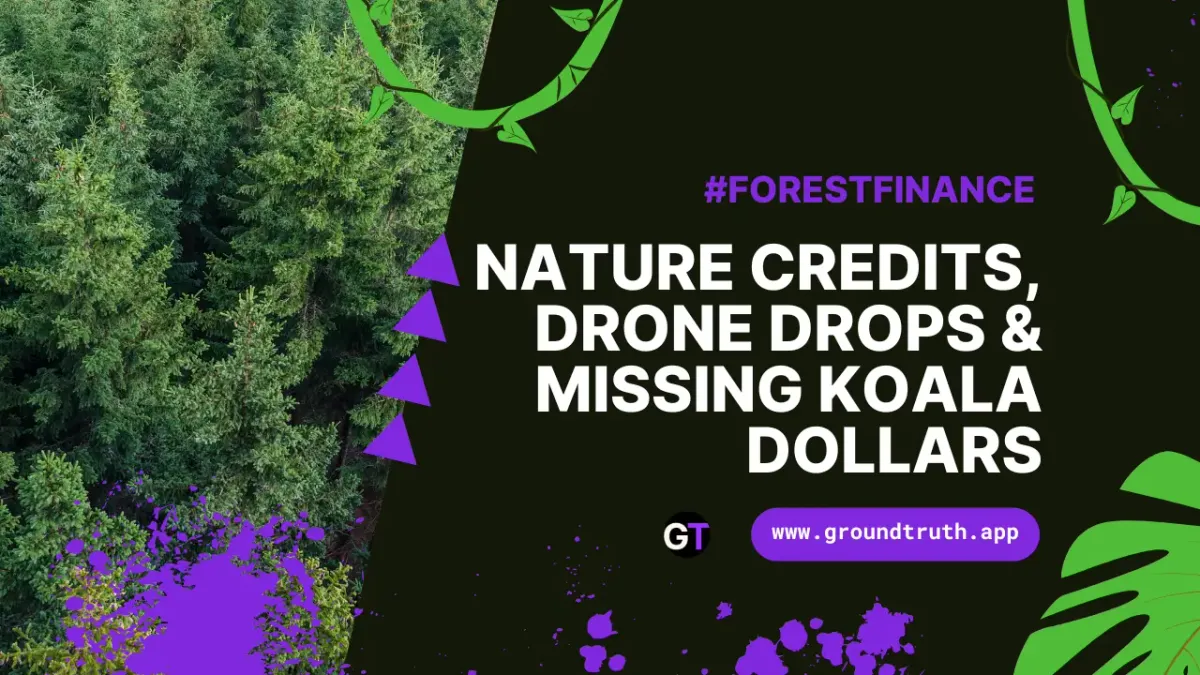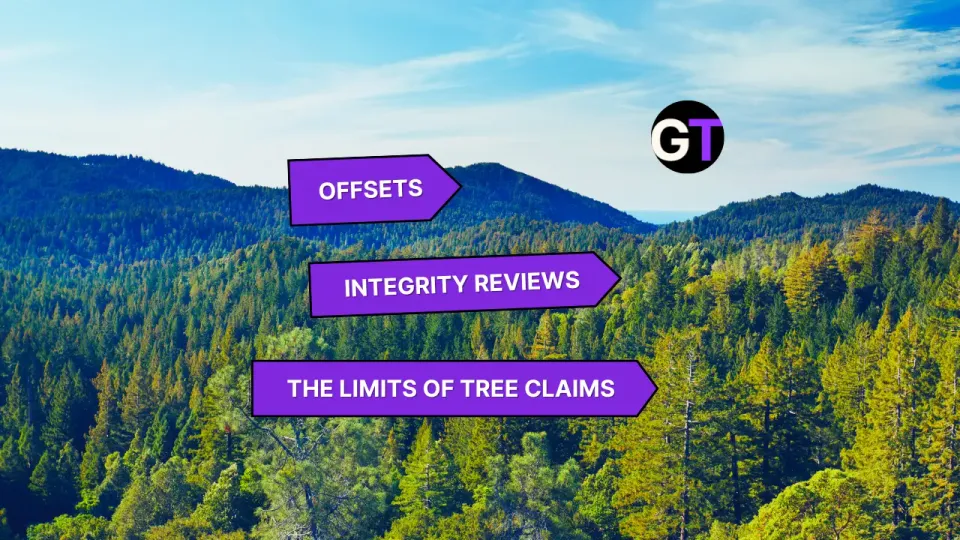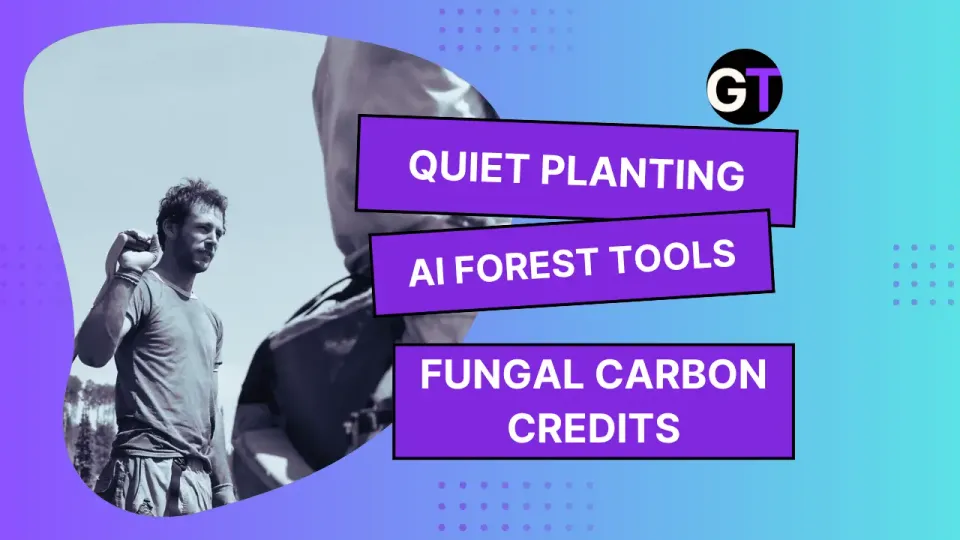Nature Credits, Drone Drops & Missing Koala Dollars
Weekly reforestation and conservation finance roundup, June 26, 2025.

Carbon Funds Target ≥15% Returns—But Timelines Don’t Always Align
Carbon funds investing in early-stage nature-based projects typically target internal rates of return (IRR) of 15% or more, according to a recent masterclass by CrossBoundary Group. These funds invest in carbon credits through offtake or streaming agreements, aiming to hold and resell credits over a ~12–15 year fund lifespan. But that timeline can clash with the delayed issuance of afforestation credits—raising questions about how viable such projects are for traditional carbon finance models.
💬 Can ARR projects meet investor expectations—or do we need new finance structures?
👉👉 Watch the full Gold Standard masterclass on YouTube
Enhancing Climate Finance Access for Indigenous Peoples and Local Communities
A new report outlines how direct financing mechanisms—especially through Payments for Ecosystem Services (PES)—can improve outcomes for Indigenous Peoples and Local Communities (IPs and LCs). It highlights how current finance systems often exclude these groups due to complex requirements, limited participation in project design, and a lack of tailored support. The report offers practical recommendations, including simplifying access criteria, ensuring meaningful participation, and directing funds toward governance, capacity-building, and secure land tenure. Case studies from Latin America and Africa show how PES can not only drive conservation but also support cultural revitalization and livelihood security.
💬 How can we ensure Indigenous Peoples and local communities have direct access to the climate funds meant to support them?
👉👉 Read the full report from the WRI
Biodiversity Credits: An Overview of the Current State, Future Opportunities, and Potential Pitfalls
A new paper provides a comprehensive overview of voluntary biodiversity credits—drawing lessons from past conservation incentives such as biodiversity offsets, PES, and voluntary carbon markets. The authors highlight growing interest in biodiversity credits but stress the need for clear standards, social safeguards, and mechanisms to ensure additionality, permanence, and equity. Key distinctions between offsets and credits are clarified, while case studies and instrument comparisons offer practical insights into design and deployment. While early signs show some progress (particularly on social safeguards), the authors caution that without robust governance, biodiversity credits could repeat the pitfalls seen in earlier markets.
💬 How can open data help avoid repeating the mistakes of past conservation incentive mechanisms?
👉👉 Read the full paper in Business Strategy and the Environment
Trillion-Dollar Investor Alliance Presses for Swift Action on Deforestation Risk
The Net Zero Asset Owner Alliance, representing over $9.5 trillion in assets and backed by the UN, has issued new guidance urging financial institutions to manage deforestation risks in their portfolios by 2030. One-third of companies tied to forest-risk commodities still lack public no-deforestation commitments, and most aren't tracking their progress. The guidance supports standards like TNFD and ISSB while emphasizing that investors must act as catalysts for systemic change. With the EU’s Deforestation Regulation looming and new tools like the Nature Data Public Facility on the horizon, data transparency and tech innovation are becoming central to tracking impact and compliance.
💬 Could more open-access nature data help investors spot deforestation risk before it hits the balance sheet?
👉👉 Read the full article at Sustainable Times
NSW Budget Unlikely to Allocate Extra Funding for Long-Promised Great Koala National Park
Despite being a flagship election promise, New South Wales’ long-anticipated Great Koala National Park is not expected to receive additional funding in the 2025–26 budget. The $80 million allocated last year remains the primary investment, even as conservationists warn that more than 10,000 football fields of forest have been logged within the park’s proposed footprint. Advocates say delays are harming both koalas and timber communities, while the treasurer points to budget pressures from recent natural disasters and rising workers’ compensation costs. Without new funds, progress on the park—and protection for Australia’s iconic marsupial—remains uncertain.
💬 How might open environmental data help the public track progress—or delays—in delivering on forest protection promises?
👉👉 Read the full article at The Guardian
Ten Indigenous-Led Initiatives Related to Nature Finance
To mark National Indigenous Peoples Day, the Nature Investment Hub spotlighted ten Indigenous-led initiatives that are redefining how conservation and finance intersect across Canada. These range from salmon restoration bonds in Wuikinuxv territory, to forest stewardship grounded in mycorrhizal fungi, to tokenized investment models and IPCA knowledge-sharing platforms. Each effort blends cultural resurgence, ecological care, and financial innovation—showing that Indigenous leadership is essential for designing equitable and lasting nature-based solutions.
💬 How can open data better support transparency and equity in Indigenous-led nature finance initiatives?
👉👉Read more from Nature Investment Hub
Drone Delivery for Reforestation Takes Off
Volatus Aerospace is partnering with J.D. Irving, Limited to use heavy-lift drones for Spring 2025 tree planting in New Brunswick. These drones will transport seedlings and supplies to remote sites, aiming to boost both safety and efficiency. With more than 5.3 billion seedlings needed to restore wildfire-damaged forests globally, drone logistics could play a growing role. Volatus will manage operations remotely from Ontario, positioning this tech as a scalable alternative to ground transport in rugged terrains. The global tree planting services market is expected to grow from $7.2B in 2023 to $12.5B by 2031.
💬 Can drone-based reforestation logistics scale fast enough to meet global restoration goals—or is the hype getting ahead of real-world readiness?
👉👉 Read more in Stock Titan
Alberta Invests $55M to Restore Caribou Habitat
Alberta is investing $55.8 million to plant 5 million trees across northern caribou ranges by 2030, targeting restoration of legacy seismic lines that have long fragmented habitat. The reforestation effort, aimed at supporting threatened woodland caribou, will also create dozens of jobs. Over 4,500 km of seismic lines have already been treated since 2019, with this latest push adding to more than $70 million in total restoration funding.
💬 That’s about $11 per tree—but is that a reasonable cost for this kind of habitat-focused reforestation? And where’s the data on species, survival rates, and which ranges benefit most?
👉👉 Read more on Heartland News
Ireland Pledges €1.5M to Promote Forestry Awareness
Ireland’s Department of Agriculture has allocated €1.53 million to fund 48 projects promoting forestry from 2025–2026. The funding will support initiatives like agroforestry outreach, timber-in-construction campaigns, women’s inclusion in forestry, and public engagement efforts such as “Forestry Villages” and career promotion. Officials emphasized the role of peer-led education and farmer engagement in achieving national climate and afforestation goals.
💬 Awareness matters—but how will we track whether this €1.5M investment actually boosts afforestation or changes landowner behavior? Where’s the follow-up data?
👉👉 Read more on Gov.ie
Quebec’s Climate Plan Shrinks While Forest Needs Grow
Quebec’s new $10.1B 2025–2030 climate plan touts record funding but fails to deliver meaningful reforestation gains—despite urgent need. After the record 2023 wildfires, reforestation alone cost $200M, yet the entire adaptation budget only increased by $68M this year. Critics say forest recovery is being deprioritized, with no new targets in the Nature 2030 Plan and minimal integration of nature into the broader climate strategy.
💬 If forests are central to adaptation, where’s the long-term plan—and where’s the data on how this budget actually helps them regrow?
👉👉 Read more on Climate Action Network Canada

Edited by Chris Harris

This work is licensed under a
Creative Commons Attribution 4.0 International License.





